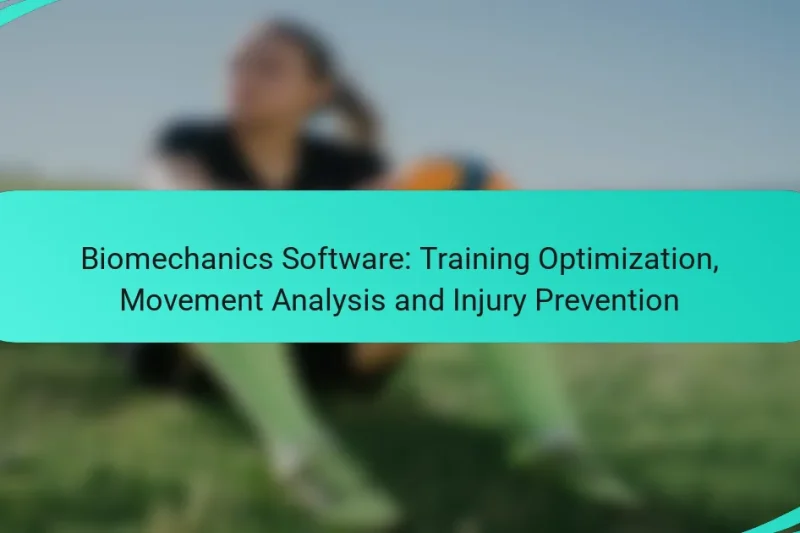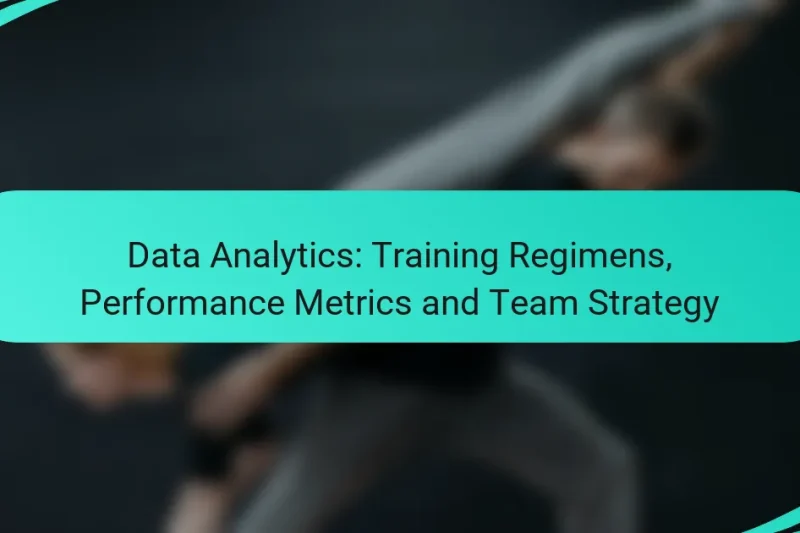Olympic training apps are essential tools for athletes seeking to optimize their performance through effective tracking … Olympic Training Apps: Performance Tracking, User Experience and Feature ComparisonRead more
Olympic Training Methodologies: Technology Integration
In the realm of Olympic training, the integration of technology has revolutionized how athletes prepare for competition. By utilizing advanced tools such as GPS tracking systems and biomechanical analysis, athletes can optimize their training regimens, enhance performance, and minimize injury risks. This technological evolution not only facilitates personalized training plans but also fosters greater engagement and progress tracking for athletes striving for excellence.
Video Analysis: Technique Improvement, Performance Feedback and Skill Development
Video analysis is a powerful tool for athletes seeking to improve their performance through visual feedback … Video Analysis: Technique Improvement, Performance Feedback and Skill DevelopmentRead more
Biomechanics Software: Training Optimization, Movement Analysis and Injury Prevention
Biomechanics software is essential for optimizing training, enhancing performance, and preventing injuries in athletes. By providing … Biomechanics Software: Training Optimization, Movement Analysis and Injury PreventionRead more
Data Analytics: Training Regimens, Performance Metrics and Team Strategy
Data analytics plays a crucial role in enhancing team performance by offering insights that drive informed … Data Analytics: Training Regimens, Performance Metrics and Team StrategyRead more
Virtual Reality: Training Innovation, Immersive Experiences and Athlete Engagement
Virtual Reality (VR) is transforming athlete training by creating immersive environments that significantly enhance learning and … Virtual Reality: Training Innovation, Immersive Experiences and Athlete EngagementRead more
Wearable Technology: Performance Tracking, Data Collection and Athlete Insights
Wearable technology has revolutionized the way athletes track their performance by delivering real-time data on critical … Wearable Technology: Performance Tracking, Data Collection and Athlete InsightsRead more
How is technology integrated into Olympic training methodologies?
Technology plays a crucial role in modern Olympic training methodologies by enhancing performance, skill development, and personalized training plans. Through various tools and systems, athletes can track their progress, simulate competitive environments, and analyze data to optimize their training regimens.
Wearable technology for performance tracking
Wearable technology, such as fitness trackers and smartwatches, enables athletes to monitor their physiological metrics in real-time. These devices often track heart rate, sleep patterns, and activity levels, providing valuable insights into an athlete’s condition and recovery needs.
For effective use, athletes should choose wearables that offer accurate data and are comfortable during training. Popular options include devices from brands like Garmin and Polar, which can help athletes maintain optimal performance levels and avoid overtraining.
Virtual reality for skill development
Virtual reality (VR) technology immerses athletes in simulated environments, allowing them to practice skills and strategies without physical constraints. This method is particularly beneficial for sports requiring precise movements and tactical decision-making, such as gymnastics or fencing.
Using VR, athletes can experience various scenarios and receive immediate feedback on their performance. Incorporating VR sessions into training can enhance muscle memory and improve reaction times, making it an effective tool for skill refinement.
Data analytics for personalized training
Data analytics involves collecting and analyzing performance data to create tailored training programs for athletes. By examining metrics such as speed, endurance, and technique, coaches can identify strengths and weaknesses, allowing for targeted improvements.
To implement data analytics effectively, athletes should work with coaches who can interpret the data and adjust training plans accordingly. Utilizing platforms like TrainingPeaks or Strava can help athletes track their progress and make informed decisions about their training strategies.
What are the benefits of technology in Olympic training?
Technology in Olympic training offers significant advantages, including enhanced performance tracking, improved injury prevention, and increased athlete engagement. These benefits help athletes optimize their training regimens and achieve peak performance during competitions.
Enhanced performance measurement
Technology enables precise performance measurement through tools like wearable devices, motion sensors, and video analysis. These tools provide real-time data on metrics such as speed, heart rate, and technique, allowing coaches to tailor training programs effectively.
For example, athletes can use GPS trackers to monitor their running distances and speeds, while video analysis can help refine their techniques. This data-driven approach can lead to improvements in performance by identifying strengths and weaknesses.
Injury prevention through monitoring
Integrating technology into training helps monitor athletes’ physical conditions, reducing the risk of injuries. Wearable devices can track biomechanical data, such as joint angles and muscle strain, alerting coaches to potential issues before they escalate.
Regular monitoring can lead to adjustments in training intensity and volume, promoting safer practices. For instance, if an athlete’s workload exceeds recommended thresholds, coaches can modify their training plans to prevent overuse injuries.
Improved athlete engagement
Technology enhances athlete engagement by providing interactive training experiences and personalized feedback. Apps and platforms can gamify workouts, making training more enjoyable and motivating for athletes.
Moreover, athletes can receive instant feedback on their performance, which fosters a sense of ownership over their training. This engagement can lead to increased dedication and improved outcomes, as athletes are more likely to stay committed to their training regimens when they see tangible progress.
Which technologies are most effective for Olympic athletes?
Effective technologies for Olympic athletes include GPS tracking systems, biomechanical analysis tools, and smart equipment that provides real-time feedback. These technologies enhance training efficiency, improve performance, and reduce the risk of injury.
GPS tracking systems
GPS tracking systems are essential for monitoring an athlete’s movement patterns, speed, and distance covered during training and competition. They provide valuable data that helps coaches adjust training regimens based on performance metrics.
When using GPS technology, athletes can analyze their performance over time, identifying trends and areas for improvement. Many systems offer features like heart rate monitoring and geofencing, which can enhance training effectiveness.
Biomechanical analysis tools
Biomechanical analysis tools assess an athlete’s movement mechanics to optimize performance and prevent injuries. These tools often include motion capture systems and force plates that measure how athletes interact with their environment.
By analyzing data from these tools, coaches can identify inefficient movement patterns and make necessary adjustments. For example, a runner might alter their stride length or frequency based on insights gained from biomechanical assessments.
Smart equipment for real-time feedback
Smart equipment, such as connected wearables and training devices, offers real-time feedback to athletes during their workouts. This technology allows for immediate adjustments, which can enhance training outcomes significantly.
Examples include smart shoes that track running metrics or weightlifting equipment that provides feedback on form and technique. Athletes should choose devices compatible with their training goals and ensure they are user-friendly for optimal integration into their routines.
What are the challenges of integrating technology in training?
Integrating technology in training presents several challenges, including high costs, data privacy concerns, and resistance to change among coaches. These factors can hinder the effective adoption of advanced training methodologies that leverage technology.
High costs of advanced equipment
The financial investment required for advanced training equipment can be substantial, often reaching thousands of dollars. This includes costs for specialized devices, software, and ongoing maintenance. Many organizations may struggle to justify these expenses, especially when budgets are tight.
For example, high-performance motion capture systems or wearable technology can cost anywhere from several hundred to tens of thousands of dollars. Teams must weigh the potential benefits against their financial constraints to make informed decisions.
Data privacy concerns
As technology collects vast amounts of data, concerns about data privacy and security become paramount. Athletes’ personal information and performance metrics must be protected to comply with regulations and maintain trust. Breaches can lead to significant repercussions, both legally and reputationally.
Organizations should implement robust data protection measures, including encryption and secure storage solutions. Regular audits and compliance checks with relevant regulations, such as GDPR in Europe, are essential to safeguard sensitive information.
Resistance to change among coaches
Many coaches may be hesitant to adopt new technologies due to a lack of familiarity or fear of disrupting established training methods. This resistance can slow down the integration process and limit the potential benefits of technological advancements.
To overcome this challenge, organizations should provide training and support for coaches, emphasizing the advantages of technology in enhancing performance. Encouraging a culture of innovation and openness to change can help facilitate smoother transitions to tech-integrated training methodologies.
How do Olympic training centers implement technology?
Olympic training centers integrate technology through advanced partnerships, infrastructure enhancements, and specialized coaching programs. These elements work together to optimize athlete performance and training efficiency.
Partnerships with tech companies
Olympic training centers often collaborate with technology firms to access cutting-edge tools and innovations. These partnerships can include software for performance analysis, wearable devices for tracking biometrics, and virtual reality systems for immersive training experiences.
For instance, a center might partner with a company specializing in motion capture technology to analyze athletes’ techniques in real-time, allowing for immediate feedback and adjustments. Such collaborations can significantly enhance training outcomes and athlete readiness.
Investment in infrastructure upgrades
To support the integration of technology, Olympic training centers frequently invest in upgrading their facilities. This can involve installing high-speed internet for data transfer, creating specialized training zones equipped with the latest technology, and ensuring that all equipment is compatible with new systems.
Upgrades may also include smart training environments that adjust based on athlete performance metrics, providing tailored training conditions. These investments are crucial for maintaining a competitive edge in athlete preparation.
Training programs for coaches
Coaches at Olympic training centers receive training on how to effectively use new technologies in their coaching practices. This education often includes workshops, online courses, and hands-on training sessions to familiarize coaches with the latest tools and methodologies.
By equipping coaches with the knowledge to leverage technology, training centers ensure that athletes benefit from data-driven insights and strategies. This approach helps create a culture of continuous improvement and adaptation in training regimens.
What role does data analytics play in Olympic training?
Data analytics plays a crucial role in Olympic training by providing insights that enhance athlete performance and optimize training regimens. By analyzing various metrics, coaches and athletes can make informed decisions that lead to improved outcomes.
Performance optimization
Performance optimization through data analytics involves the systematic collection and analysis of performance metrics, such as speed, strength, and endurance. Coaches can track these metrics over time to identify trends and areas for improvement.
For example, wearable technology can monitor heart rate and recovery times, allowing athletes to adjust their training intensity. By analyzing this data, athletes can fine-tune their workouts to maximize efficiency and minimize the risk of injury.
It’s essential to establish clear performance benchmarks based on historical data and competitive standards. Regularly reviewing these benchmarks helps athletes stay focused on their goals and adapt their training strategies as needed. Common pitfalls include over-reliance on data without considering individual athlete needs and failing to adjust training plans based on real-time feedback.



